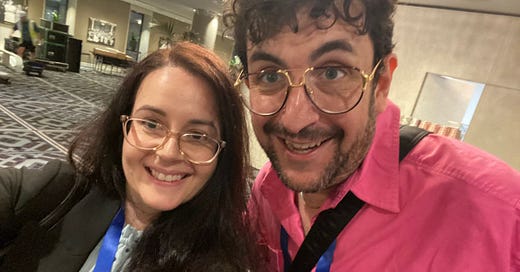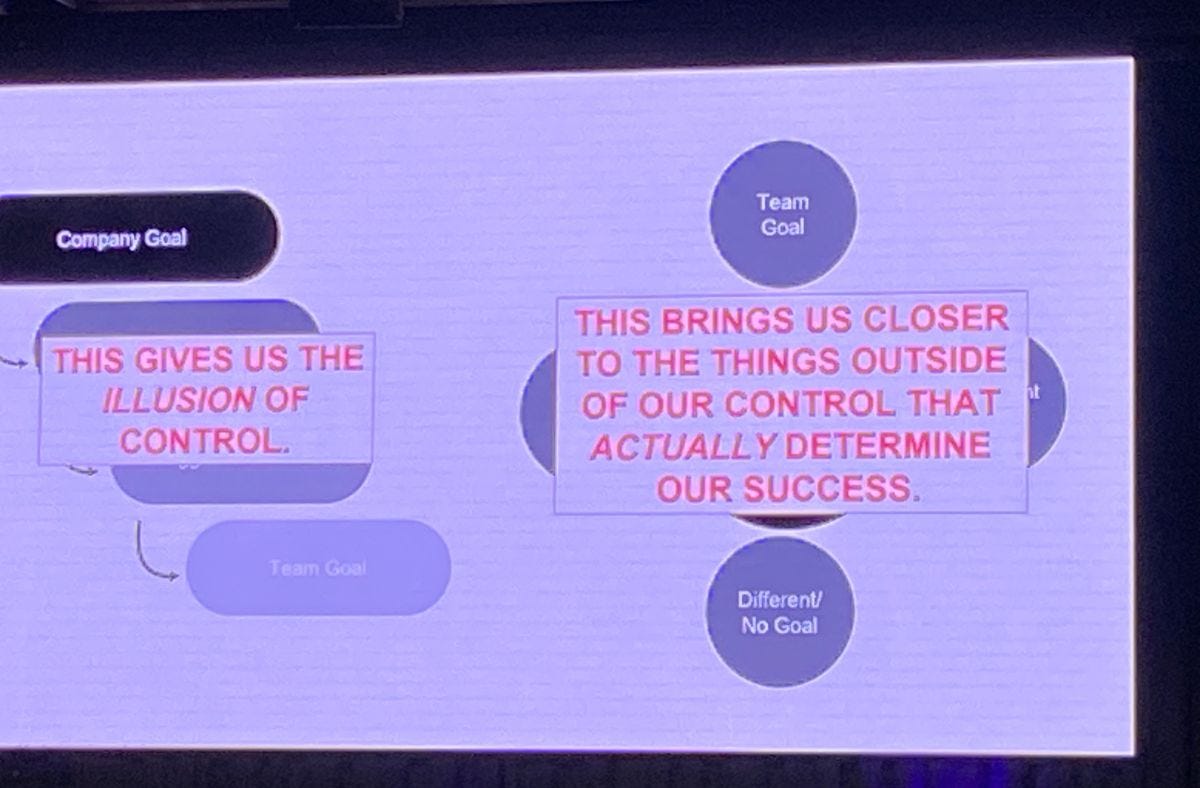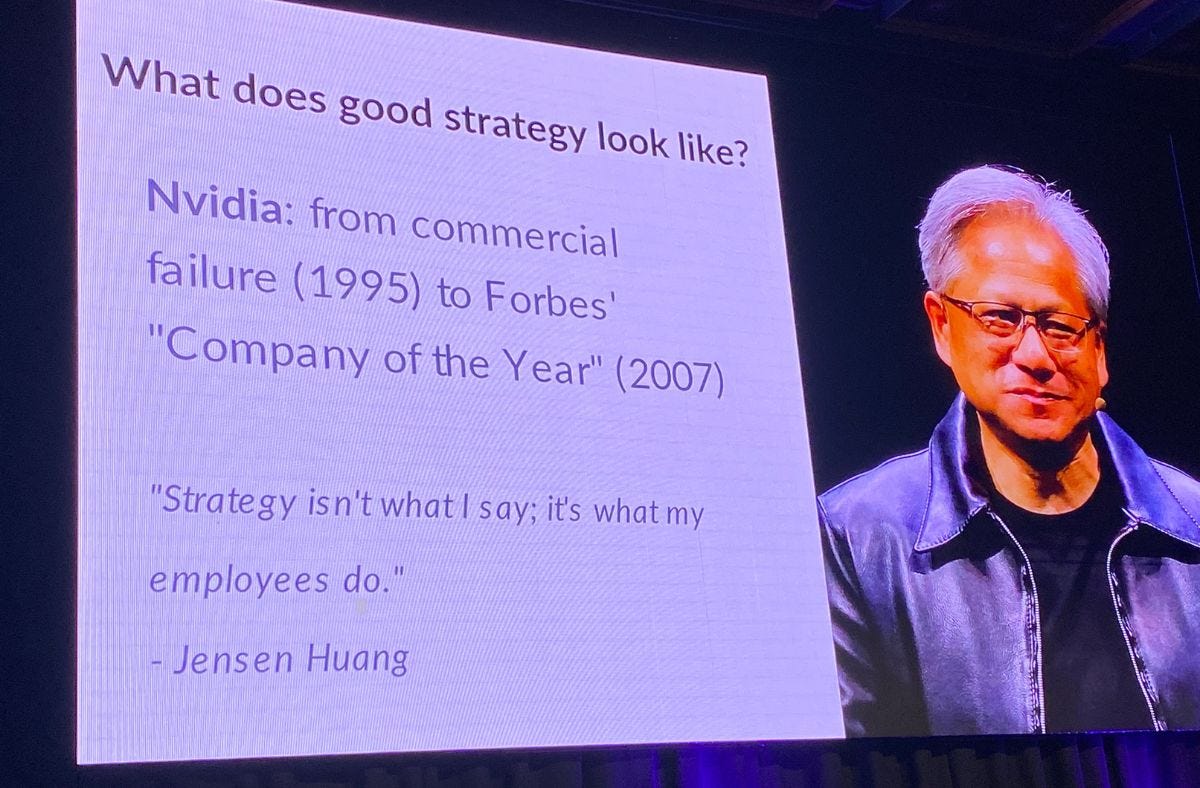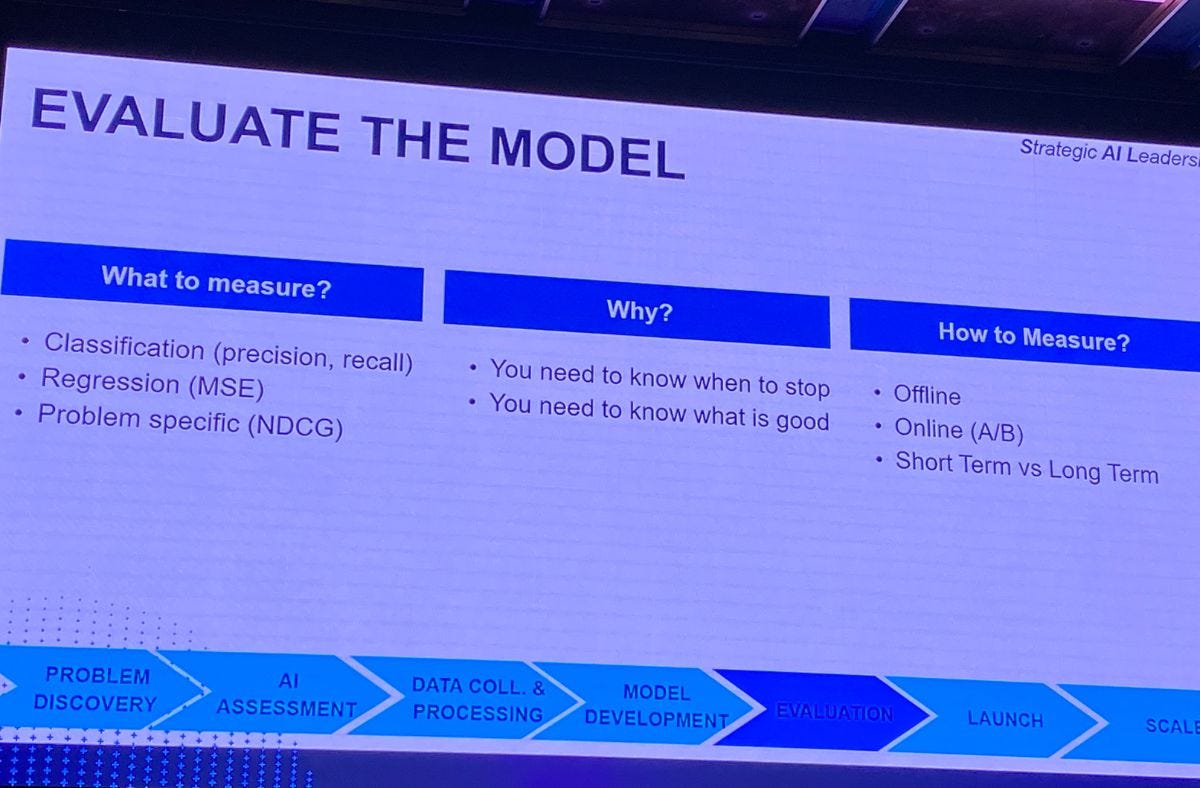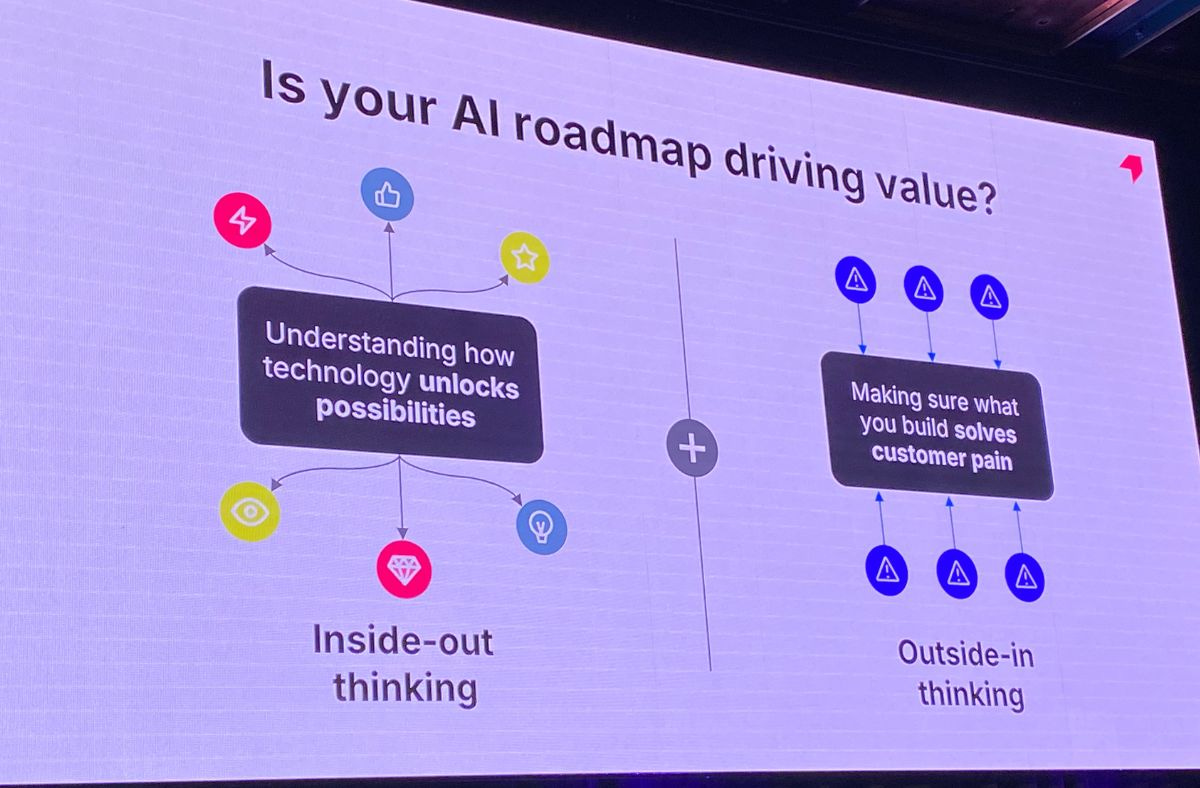Insights from Leading the Product 2025: Impact, Influence, AI, and Strategy
Matt LeMay, Cassidy Fein, Vinod Suresh and more shared practical advice on strategy, AI, impact, and influence in product leadership.
This year, for the first time ever, I had the chance to attend Leading the Product in person in Sydney. It was held on Friday 16th of May 2025 at Sofitel Sydney Wentworth and organised by the team at Brainmates.
Since the conference, many people have asked me about the talks and what I’d learnt. Below is my summary and highlights from the day.
More than watching the talks, was the value of meeting product friends in person - in the line waiting for our passes, in the coffee breaks, around the lunch table, at the after party. Please enjoy my (grainy) photos.
👋I’m Irene Liakos. A product management and growth expert with over 2 decades of experience growing product profitably across Telco, Banking, Fintech, AI, Data, Travel, Ecommerce and more. I teach, coach and advise product managers and business leaders. Reach out to me if your products aren’t delivering the value you need for your business to grow. You can contact me at irene@phronesisadvisory.com
Back to the talks!
🎯 “Would you fully fund your own team if you were CEO?”
Based on all the conversations and messages I received after the event, Matt LeMay’s talk was a stand out!
Super engaging, informative and funny I was quietly nodding and giggling in agreement while he presented. In fact, he had everyone nodding along and responding with laughter in the room.
Matt’s talk centred on impact—and it was powerful.
Referencing popular frameworks like ICE and RICE, Matt stripped it all back and reminded us: the only thing that really matters is the “I” — Impact.
Matt LeMay did not come for fluff. In his talk “The Business is Your Business,” he asked the kind of question that hits like a cold plunge: direct, uncomfortable, and exactly what we needed.
He challenged us to look beyond surface-level rituals and examine the true value our product teams deliver. Matt’s core message was clear: you’re not just here to tick boxes. You’re here to drive real, measurable business outcomes.
As someone who teaches Product Financials, I often explain how we define impact in for-profit organisations: the financial bottom line, the product P&L.
But Matt went further, he also addressed what impact looks like in not-for-profit (NFP) settings, a question that comes up often when I run the ICAgile Certified Product Management course with aspiring product leaders from social enterprises and government.
So inspired, I downloaded Matt’s book “Impact-First Product Teams” on Audible and devoured it over the next few days.
His story about leading product prioritisation at the UK’s NHS during COVID was jaw-dropping. In this context, working on the wrong things meant people dying. You want to get prioritisation for impact right here!
Beyond the points above, two insights resonated:
1.The low-impact product work death spiral.
Matt articulated this common trap so well with a simple three-point loop:
More low-impact work → more complicated products → more dependencies and conflicts → more low-impact work.
I could almost picture a hamster in the centre of that spinning wheel. Running faster but going nowhere. It’s a cycle so many teams fall into, and Matt’s framing made it stick.
2.His OKR structure, and the illusion of control.
Rather than insulating each team’s goals in siloed metrics, Matt argued for direct alignment with the company’s core objective.
Ironically, doing this doesn’t give us more control. It actually forces us to grapple with the uncontrollable realities that shape our outcomes.
He grounded this idea with a quote from philosopher Alan Watts:
“The disappearance of the old rocks and absolutes is no calamity, but rather a blessing. It almost compels us to face reality with open minds.”
In a world of shifting priorities, it’s a reminder to stay close to the why and be honest about what really moves the needle.
Missed him at LTP?
Don’t stress. Matt will be joining us on Product Circle Chat. Reserve your spot here.
💥 “Influence isn’t luck. It’s prep, timing, and operational rigour.”
Vinod Suresh’s talk, “Influence Like a Pro: The Art of Getting Things Done Without Authority,” was a masterclass in modern leadership. He reminded us that influence is for everybody—not just the execs with parking spots and titles.
“PMs must act like CEOs, but without the authority, budget, or fancy executive parking spot.”
Product Super Powers
The real superpower for Product Managers influencing without authority is
1. Lowering resistance
2. Adapting to change
3. Turning initiatives into movements
Any wonder why experienced product managers become masters at adaptability and managing change?
Make Friends
One other piece of wisdom he mentioned was to “make the Commercial Person your best friend!”
I swear by this!
His reminder to “make the Commercial Person your best friend” had heads nodding across the room. Because in the world of product, empathy, timing, and strategic relationship-building often matter more than reporting lines.
Learn what impact means in your organisation and position your product activities to help (not hinder) this value creation.
The Elevator Pitch
Vinod also made an excellent point of preparing an elevator pitch for your most important ideas.
As Product Managers, we’re often driving a change and trying to influence outcomes. All without the luxury of formal authority.
This often means getting into the calendars of senior execs, which can be next to impossible. That’s why Vinod described his scrappy tactic of catching execs on their way to the bathroom just to get a moment of face time.
Extreme? Maybe.
But the takeaway is powerful: always be ready with a short, sharp pitch. When those rare windows of opportunity open—planned or unplanned—you’ll be ready to plant a seed, pitch an idea, or get your initiative on the radar.
For me, these were moments in a shared elevator, while waiting for our coffees or in the hallway. You only had a finite amount of time to have their attention, so I had to make it count.
Personally, I wouldn’t recommend lurking outside the loo... but I absolutely agree with having a concise, compelling pitch up your sleeve at all times. In large orgs, those micro-moments of influence can make all the difference.
This forces us to be succinct with our message.
Get to the point. But leave a lasting (positive) impression.
💡 “Strategy isn’t what I say. It’s what my employees do.”
We’ve all heard the vague feedback—“be more strategic.” But Cassidy Fein did the rare thing and made it actionable.
Her talk sliced through ambiguity with sharp insight and humour, laying out what strategy actually looks like in practice: clear thinking, deliberate choices, and focus. She even brought up BlackBerry as a cautionary tale. A reminder that past success can blind us to future risk.
She had me from the moment she mentioned the BlackBerry. I was in the Telstra product team in the late 2000s, working closely with the BlackBerry product managers. Seeing that play out, the obsession with keyboards over customer value, and how they missed the shift to touchscreens… it hit home. Watch the “Blackberry” movie if you want to experience what was going on or reach out to me for a coffee and I can tell you from my perspective.
Her reference to the Ford Pinto case study (reminded me of “The $10K Car” episode in American Auto) added context and clarity. She delivered actionable advice with energy and humour, including a quote from Nvidia’s Jensen Huang:
“Strategy isn’t what I say. It’s what my employees do.”
Cassidy’s TL;DR:
Think like a consultant—look at the whole board.
Ground your strategy in diagnosis, guiding policy, and cohesive action.
Use storytelling and stakeholder alignment as proof.
Communicate clearly, consistently, and energetically.
Feedback is usually a gift—use it.
🤖 “Not every business problem needs an AI solution.”
AI was front and centre throughout the conference and Derya Isler brought grounded realism to the hype in her talk, “Bridging the Gap: Product Management in the Age of AI.”
She walked through how building AI products reshapes the product lifecycle and why your data strategy is everything. It’s not just about fine-tuning models, it’s about choosing, collecting, and managing data with precision.
Derya’s key takeaways:
AI won’t replace humans—but those who understand it will replace those who don’t.
AI transforms experiences and unlocks previously impossible outcomes.
PMs with AI fluency are in high demand—and paid accordingly.
Her key advice?
Resist the urge to jump straight into AI unless there’s a clear business case and ROI.
Meanwhile, Erica Wass echoed a similar sentiment in “Beyond the Hype.”
AI isn’t here to replace PMs. It’s here to amplify us.
Let it handle the repetitive tasks so we can focus on the human work: collaboration, insight, and building trust.
Erica had an excellent slide outlining 5 ways to use AI and had me thinking how I’ve incorporated it into my day to day work to help me amplify my impact.
The 5 ways to use AI:
Search – Analyse trends, competitors, sentiment.
Scenario Generator – Explore alternate futures.
Sparring Partner – Challenge biases and assumptions.
Experimentation Engine – Test ideas rapidly.
Decision-Making Aid – Synthesise complex data into insights.
🚀 Vision, growth, and career reflections
Ryan Salomon presented in the afternoon with a calm, thoughtful session on the evolution of products in an AI-first world.
His message?
Stay close to customer feedback—because no matter how advanced the tools get, your north star is still the people you serve.
Drawing on frameworks like OODA (Observe, Orient, Decide, Act) and quotes like “Fall in love with the problem, not the solution” (Uri Levine), he urged us to connect AI roadmaps back to customer value.
His question lingered long after his talk ended:
“Is your AI roadmap delivering value?”
That’s the crux. Whether we’re building with AI, scaling teams, or evolving strategy, the goal is still the same: build something that matters.
The panel discussions were equally compelling.
The “dice” format used in the Sydney panel on product failures added levity to serious themes, while the career growth panel shared honest reflections about mentorship, collaboration, and the hustle behind the scenes.
What I loved most in this talk was realising that you don’t need to have a mentor from product management and you can reach out to others in the organisation, other domains, for mentoring help. Having had my own mentors in areas where I’ve identified I want to improve throughout my career have helped me get better at my role.
“Having a mentor who can open doors is a gift. But once you’re in, it’s up to you to show you deserve to stay.” - Theresa Huang
Plus, I got to see the amazing people I’ve met who’ve attended Product Circle Chat over the years, old friends I’ve worked with and new friends I met on the day.
📓 This article was written in collaboration with Amaar Iftikhar and Eva Liu.
❓ Want to keep the learning going (without the plane ticket or co-ordinating travel) - come to Product Circle Chat!
Follow the Product Circle Chat calendar on Luma
Volunteer as a cohost.
Tell me who else we should invite as a speaker.
Speakers are booked 6 months to a year ahead.
With the explosion of product, tech, growth and design product thinking, learning from a new speaker every second week is a privilege!
Are you new to Product Management and want to learn from me?
I created a Course. For people new to Product Management.
Aligned it with the Learning Outcomes created by Product greats like Jeff Patton and others. Had it certified by the globally recognised ICAgile.
Choose to spend 2 days learning from me - either face to face or via Zoom - with ICAgile Certified Professional in Product Management (ICP-PDM).
And if you’re looking for a sneaky discount, send me an email at irene@phronesisadvisory.com

